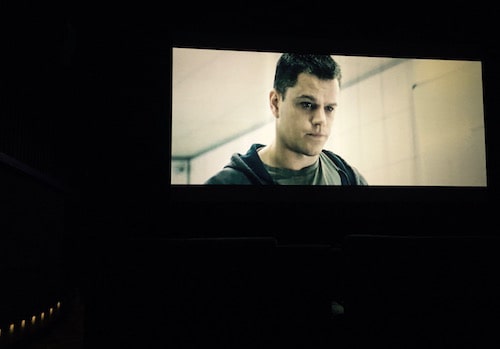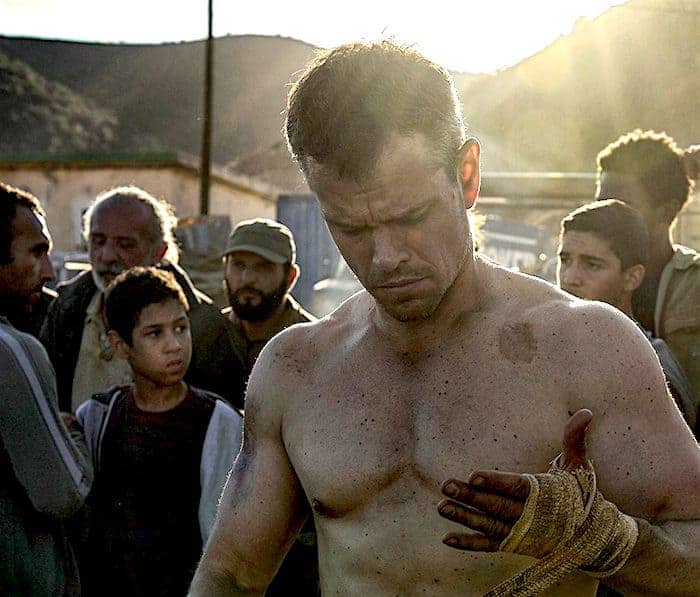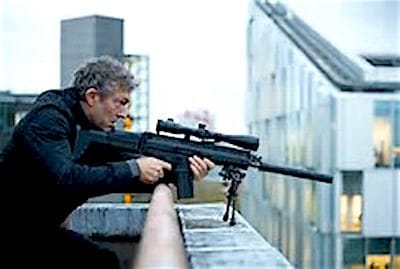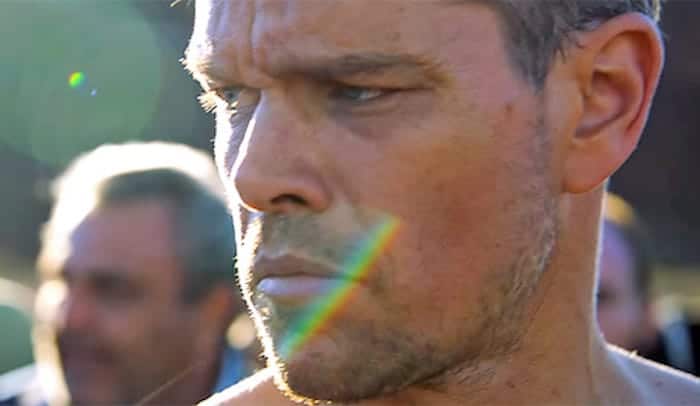I’m a fool for Big Screen movies. No hand-held device, no TV, no laptop will ever be able to deliver that tangible, chewable breathtaking immersion in another reality that movies seen in a theater can do.
Before you think “oh how yesterday,” consider the obvious. Movies in a darkened theater force your full attention onto that screen and into the action, into the lives, fortunes, and dangers of characters who come to life — larger-than-life! — for two hours.
The darkness places us in a magical space, a space without distraction (yes Millenials, it’s possible). Hence everything we see is intensified. The visual impact of huge figures, explosions, long, burning kisses, it not only a feast for the eyes, but an orgy for our bodies. Film is a physical experience, delivering through our bodies the sense that we have actually been somewhere new, different, exotic that looking at a photograph or even watching a play simply cannot emulate.

So why is that an image of Matt Damon at the top of this post? Because I have been thinking about Jason Bourne for a few weeks now. The fifth installment of Robert Ludlum’s anguished, buffed, amnesia-driven CIA operative continues to pack a wallop. (Full disclosure: I have no problem watching buffed men fighting other buffed men. On the screen, that is. My mother enjoyed watching men at construction sites. She drove very slowly by road crews pointing out the areas of interest. She claimed to have been fascinated with heavy machinery. . . so I grew up having her point out men on rooftops, usually without shirts, sweating in the hot sun over righteous labor. The apple doesn’t fall very far, etc. etc.)

At any rate, while the latest Bourne installment lacks the incendiary opening chases that have distinguished some of the others, notably The Bourne Ultimatum, it does offer a voyeuristic glimpse of Matt Damon’s enduring abdominal aesthetic before careening through a cascade of surveillance pornography that is, I’ll admit, very much to my taste.
Here in a nutshell is why the film works. Explosions bounce off slow, still shots of the CIA black ops inner sanctum. Crowds—fanned into euphoric chaos by throbbing techno-music—play off solo shots of Bourne as he replays the moment of his father’s betrayal over in his mind. In the dark theater, alone with my popcorn, I am plunged inside the danger, the rioting, the introspection. The film intertwines two surveillence programs at work in 21st century global politics: digital surveillence and governmental surveillence. Tommy Lee Jones (who, as head of the CIA’s ultra-secret shadow program, has a face like a trainwreck and a voice like Tupelo honey) urges his new cyber surveillence protegé, played with little conviction by a miscast Alicia Vikander, to bring in Bourne. But Jones’ character is also in bed with a Google-esque Silicon Valley genius, who has agreed to deliver a “back door” surveillence into an internet application used by 1.5 billion users. Double entry surveillence. Yes, clever.

But more interesting is the web of spies chasing spies best embodied by the “Asset” played by Victor (another gorgeous bruised face) Cassel, let loose by the CIA to take out Bourne before he can come in from the cold. It will, in the end, be Bourne chasing the Asset chasing Bourne. And the race to kill or be killed leads from Rekyavik, to Berlin, through London, and ultimately into the Vegas Strip.
The mother of all car chases happens as Cassel — driving a SWAT-team Hummer— and Bourne —in an impossibly fast Camaro—take out literally dozens of cars, driving wrong-way through Las Vegas (what fun!) and finally down into the sewer system for the final hand-to-hand, blood-drenched confrontation. I could have used a second round of popcorn for this one.
Throughout the film the key male players take a long hard look in the mirror, considering what they have become, before they continue on to swift revenge. Movies such as this are powered not only by over-the-top speed, richly saturated cinematography, and haunting juxtapositions of individuals, architecture, and drop-dead gorgeous shots such as world capitals, lit up at night, seen from the air. They also fuel our needs by providing an inevitability that is lacking in real life. Doorways really do lead to the answers in such spy genre revenge capers. Cars fly through casinos and somehow survive. How are these guys still alive? I wonder after the fifth brutal confrontation between our antagonists.
Because it’s a movie. It’s a fable seducing us into its “likely story” narrative. Not forever. Just for a few hours. To be unplugged, released from a keyboard, freed from intellectual responsibility—just for a few hours. My answer is always “yes.”



Christina, how are you Sweet. Just read you treatise on the Bourne thing. God, you’re a good writer. But I’ll have to say, you didn’t discribe that film the way I would have. I thought it was a big unhealthy noise from beginning to end. Films like this one should be illegal. I came out of the theatre racked and sweating. ‘No more’ I said to Jill. Never again. Getting too old for this shit. Did you sleep allright that night, Christina? I know we all have our likes and dislikes, but some of this stuff is absolutely dangerous. I’m ashamed of some of the things I do let pass through me in the name of ‘entertainment’ but, I could tell this was poison, even as I wrapped my head around it.
As the latest Star Trek production. My hearing was wracked, the effects more over the top if you are 18 but I was hoping for something more cerebral that I could hear the dialogue over the special effects noise and slurred lines spoken. Ray always says it like it is which I always respected instead of the fluff of total politeness. Seen all the other Bourne films, why not one more?
I have always read, liked and valued your film opinions but I absolutely love your writing talent. Well done (again)!!